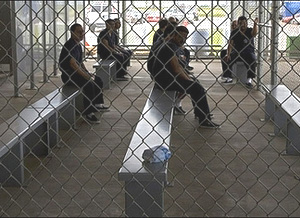 |
 |
 |
 News from Around the Americas | May 2007 News from Around the Americas | May 2007  
Prison Conditions Prevail at US Immigrant Holding Center
 Mauricio Rabufetti - Agence France Presse Mauricio Rabufetti - Agence France Presse


| | Detainees wait to be processed inside Homeland Security's Willacy Detention Center, 10 May 2007 in Raymondville, Texas. Stark, prison-like conditions prevail at a US detention complex for undocumented immigrants which holds 2,000 foreigners, mainly from Latin America. (AFP/Paul J. Richards) |
Raymondville, TX - Stark, prison-like conditions prevail at a US detention complex for undocumented immigrants which holds 2,000 foreigners, mainly from Latin America, just north of the Mexican border.

Flanked by two real prisons, the Willacy County Detention Center in Raymondville, Texas is made up of 10 windowless, dome-shaped tents, each the drab color of sand and about half the size of a football field.

The complex is surrounded by chain-link fences topped with rolls of razor wire, and is protected by private guards.

Inside are bunkbeds, communal showers, and people like Karina, 27, who is from El Salvador and who has been at Willacy for one month waiting for her case to be resolved.

"I came to struggle for my family and my children," she told reporters who toured the site, escorted by US immigration officials. "We wanted to cross (the border) over to the other side, but they caught us."

The woman was the only female detainee authorized to speak with reporters. Immigration agents allowed her to talk only on condition she did not reveal her real name.

Karina had hoped to work in the United States and send money home to El Salvador to help support her two sons, aged six and two. Instead she was caught, and now she could be deported and banned from entering the country again.

The Willacy center is a key part of the Department of Homeland Security's Border Security Initiative announced last year to turn back the huge tide of people, mostly from Latin America, seeking to enter the United States for jobs.

According to immigration officials, the plan seeks to "secure and gain control of America's borders" by making sure that "illegal aliens are detained and removed from this country as expeditiously as possible."

Still, immigration officials insist on referring to those held here as "detainees," not prisoners, because even though they violated US law, they are not considered criminals, according to US Immigration and Customs Enforcement (ICE) public affairs official Nina Pruneda.

The undocumented immigrants inside the site, located some 70 kilometers (43 miles) north of the Mexican border, are awaiting an "administrative process" of their case, added Fred Fierro, one of the ICE officials in charge of the site.

The Willacy residents come from more than 30 countries around the world, though a full 80 percent are from El Salvador, Fierro said. There are also a handful from Africa, Europe and Asia.

Many were arrested across the United States during dragnets by ICE agents over the past several months. Others were detained after illegally crossing the border from Mexico.

On average, men and women stay at Willacy between 18 and 21 days, ICE officials said, though some are known to stay for more than six months.

Some 400 people, including security guards, work at the privately-operated site, supervised by 40 government employees, ICE officials said.

Detainees receive medical checkups, are issued navy blue uniforms and surrender their belongings, which are stored in sealed plastic bins and held until they are released.

Two of the vast tents at Willacy are set aside exclusively for the 500 women held at the site.

Built in 90 days and inaugurated in August 2006, the air-conditioned tents stand over polished concrete floors. The tents are divided into four areas with some 50 bunk beds each, as well as bathrooms, showers, and recreation rooms.

"Monday through Friday our detention standards require to allow them to recreate one hour a day," said Michael Watkins, an ICE official at the site.

"Keep in mind they have more than that because they go to medical, they have barber shop, they have the general library. They have multiple things going on ... that keep them out of the dormitories," he said.

The detainees sleep eight hours per night - and at Willacy, are granted two hours of sunlight, Watkins said.

Light otherwise comes from enormous neon lights hanging from the ceiling.

Detainees are allowed to make one free call to anywhere in the world. After that, they must buy a phone card - conveniently sold on-site - to use the telephone. | 
 | |
 |



